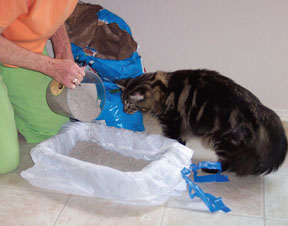Its a downright dirty job, but someone has to do it. If youre the one who changes the litter box, you already know the task isn’t a particularly pleasant one. As soon as you set down clean, fresh litter, your cat has to try it out, and the cycle starts all over again.
There are ways of making the job a little easier, however. By using the right materials, creating a litter-changing routine and keeping supplies in a convenient place, changing your cats box can be made less labor-intensive.
Here are some tips to reduce litter drudgery:
The Right Stuff
Your best bet is to use trash bags themselves as your litter liner. Heres how it works: Purchase large kitchen garbage bags with cinch ties. Turn two of them inside out. Slip your litter box inside one bag and then slip the second bag over the first. Smooth them down. Then tie each end loop from one bag to the corresponding end loop from the other bag. Next, pour in your litter – and bring on your cat.
When its time to change the litter, slowly peel back the open end of the bags, uncovering the clean litter box as you go. As you do this, you will be turning the bags right-side-out again, enclosing the litter inside the bags in the process. Grab the knotted pairs of cinch ties and tie them together. And voila! Your trash liners are now trash bag(s) with your litter inside and ready to be put out with the rest of the garbage.
The smell should be contained and there should be no spills. No more dumping and wiping up stray litter. No more having to wash the box each time you change it. (Be watchful when you first try this. Some cats may resist using a box thats been modified this way and decide to eliminate elsewhere.)
The other thing you can do is get rid of the scooper. The scooper drops litter on the way to the trash, and the scooper itself gets very grungy and needs regular cleaning.

288
Plastic Bag = Handy Scoop
“The bags neatly pick up the excrement and even the urine clumps, especially if you use scoopable litter,” says Wolf. There is no spilling and less smell, and you can just drop the bag into the trash. “For multiple litter pans, use paper towels to pick up the excrement and place it in a double plastic grocery bag that you carry with you.”
You can even purchase bags that are marketed for scooping dog poop, and you can keep an eye out for biodegradable bags to help ease the burden on the environment.
Timing is Everything
And when you clean the litter box regularly, there is less to clean up. This method has two pros: You can get away with changing the litter less often. If you use clumping litter, you may even go several weeks before having to completely change the litter box (provided that you regularly replace the litter that you remove during your daily cleanings).
The other advantage is that your cat will enjoy a clean litter box, decreasing the chances that your cat will stray from the box in search of a more acceptable toilet.
For cats that like to scratch like crazy before they eliminate, keep a large rubber mat, a tray or even a large carpet sample under the litter box to catch stray litter before it spreads all over the floor.
Wolf offers an important trick-of-the-trade tip for multi-cat households: “Every multi-cat family should have at least one box per cat plus one. After a while, youll probably notice that some boxes are used more often for feces and the rest used more frequently for urine.” The boxes that your cats use for urine, says Wolf, should be changed more often. “You can wait a bit more to change the litter boxes with feces, as long as you scoop regularly.” This way, you dont have to change every litter box every time.
Keep Kittys Box Convenient
“I listened once to an animal behaviorist who described a cat that had severe litter box problems,” says Wolf. “It turns out that the cats box was located next to the furnace in the basement. And the noise scared the life out of the cat.”
Besides causing accessibility problems for your cat, placing the litter box in an out-of-the-way spot can make it more difficult to keep the box clean. Youre more likely to clean the box regularly if its on your regular route around the house.
If you feel that your cats litter box is unsightly, you can try the covered litter boxes. However, not all cats enjoy using that type of box. And it may actually prove to be extra work for you, because you have to clean the lid when you change the litter. Many cats spray urine that lands on the inside of the lid.
Finally, stash cleaning supplies nearby. It will be a lot easier if you have everything you need in a closet or drawer near the litter box. That includes boxes or bags of fresh litter, trash bags or regular liners, a scooper or scooper bags and a bottle of disinfectant if you use it.
If you keep litter boxes on different floors in your house, its worth setting aside space and supplies near each box. That will save you time and energy when it comes to changing the boxes.



